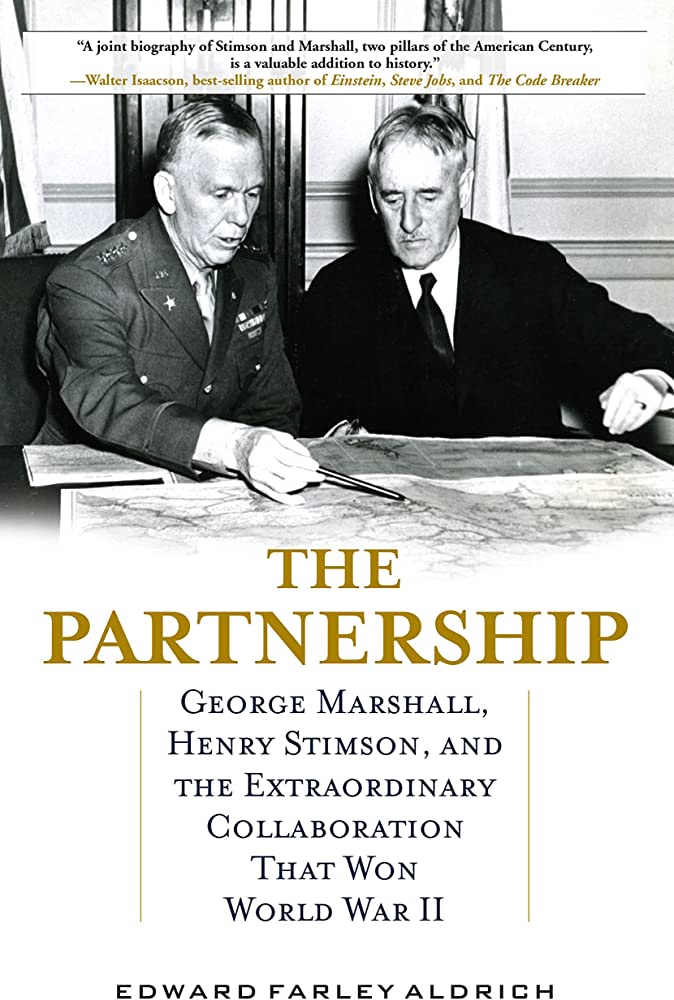Ted Aldrich wrote his critically acclaimed history—“The Partnership: George Marshall, Henry Stimson, and the Extraordinary Collaboration That Won World War II” (here at Elm Street Books, here on Amazon)—over seven years while commuting on Metro-North Railroad into Manhattan. On May 4, Aldrich will lead an author talk on the book in the Jim and Dede Bartlett Auditorium at New Canaan Library (register here).
We put some questions to Aldrich about his research, writing and book. Here’s our exchange:
New Canaanite: Before we get into the book itself, tell us about how you came to start researching what would become “The Partnership.”

Ted Aldrich
Ted Aldrich: As a lifelong history buff, and without realizing it, I had been researching this book for decades in a sense. World War II and the post-War era have long fascinated me and every book I read seemed to lead to 3-4 others so I was very well versed on the major figures and events of that time. When I was shocked to find that nothing had been written about the relationship between Sec. of War Henry Stimson and Army Chief of Staff George Marshall, I decided to begin researching it myself with the idea to write a book. On a trip to Yale University where the Stimson papers are housed, I got my hands on Stimson’s diary, 4,000 pages of which he kept during the War. With those, I had 75% of what I needed.
I understand that you wrote this book over many years while commuting to Manhattan. Set the scene for us. What is your profession and what was it like taking on this project while riding the Metro-North Railroad line?
I have been a commodity finance banker for most of my career and outside of working two years in Switzerland and three in London, I have always had a train commute from Connecticut to Manhattan. Since first starting out in the late ‘80s, I have always read history on my commute home. When I decided to write this book back in 2011 and managed to get the Stimson diaries on a thumb drive and a bunch of other books, I realized that there was no reason I could not devote the 75 minutes a day I was spending on the ride back from Grand Central to Westport to researching and writing (window or aisle seat strongly preferred). It was not efficient by any means, but as I had no deadline, I could make noticeable progress each week over the seven years it took to finish it.
World War II is a massive subject. Your book has been described as a “dual biography” that focuses on two key figures in the U.S. war effort. Give us some sense of what gap in history you’re filling in here. What has been written before about Gen. George Marshall and Henry Stimson, and what is “The Partnership” bringing out that is new?
When it comes to wars, America, like other countries, glorifies those individuals who have served on the front lines. For the World War II era therefore, authors and publishers have always favored books on Eisenhower, Patton, Bradley, MacArthur, Nimitz, Doolittle, etc. I wanted readers to realize that there were people responsible for providing these front line heroes the soldiers that were under their command. They had to feed, clothe, house, train, equip, and organize the millions of soldiers and ship them all over the world to where the fighting was going to take place. Not only that, but they had to oversee the design and manufacture of all the weapons, ammunition, and supplies required for the soldiers to fight, ship them all over the world as well, and also be responsible for the overall strategy on how men and materials were going to be used. Marshall and Stimson were the two men in charge of all this for the Army and Air Force and I maintain that what they accomplished was the greatest feat of management in the history of the world. There had been a few books on Marshall, hardly any at all on Stimson, and none on their joint effort. My book describes what they accomplished and gives a background on each man which is key to understanding how remarkable their working relationship was.
How has your book been received?
Very well critically. I have had a lot of historians including Walter Isaacson, Michale Beschloss, Evan Thomas, and Kai Bird tell me how important a book on Stimson and Marshall was to understanding World War II. For the reasons I mentioned, however, praise for a book on these two men does not translate to big sales. As a publisher who rejected the book told me, “There is not a lot of interest out there for men who sat at desks in Washington during the War.” My book aims to change this narrative.
Tell us about the May 4 talk at New Canaan Library. What can attendees expect?
Besides wonderful and humorous stories and a lot of photos, attendees will leave with a huge appreciation for these two men who were not only highly accomplished, but also known as men of the absolute highest integrity. The only thing I can guarantee is that nobody will be bored.
What else would you like to say about yourself, the new book or anything else connected to this project?
Towards the end of his life, Dwight Eisenhower was asked who the greatest American he ever met was. Without hesitation, he answered, “George Marshall, with Henry Stimson a close second.” Given that Eisenhower met countless great men over his life including the eight years he was president, this speaks to how remarkable these two men were. I have written the book not just for those who are World War II buffs, but for anyone who wants a better understanding of how the war was won.
